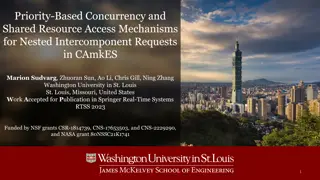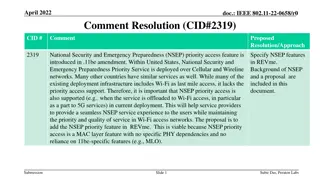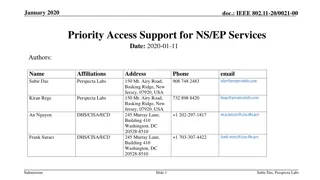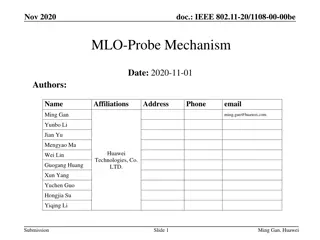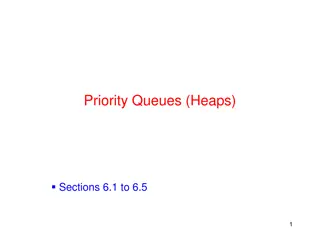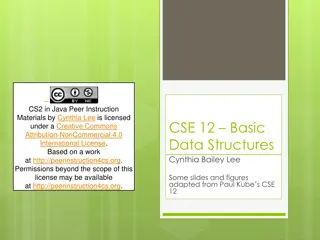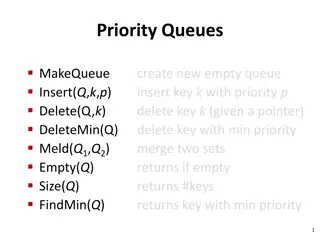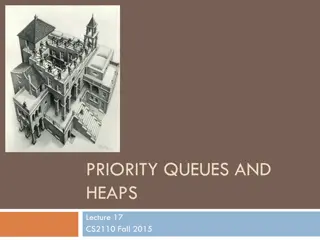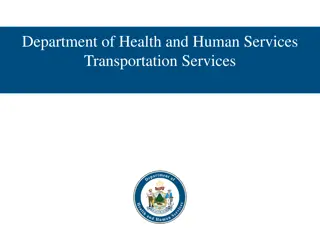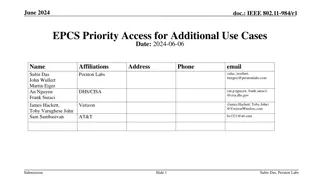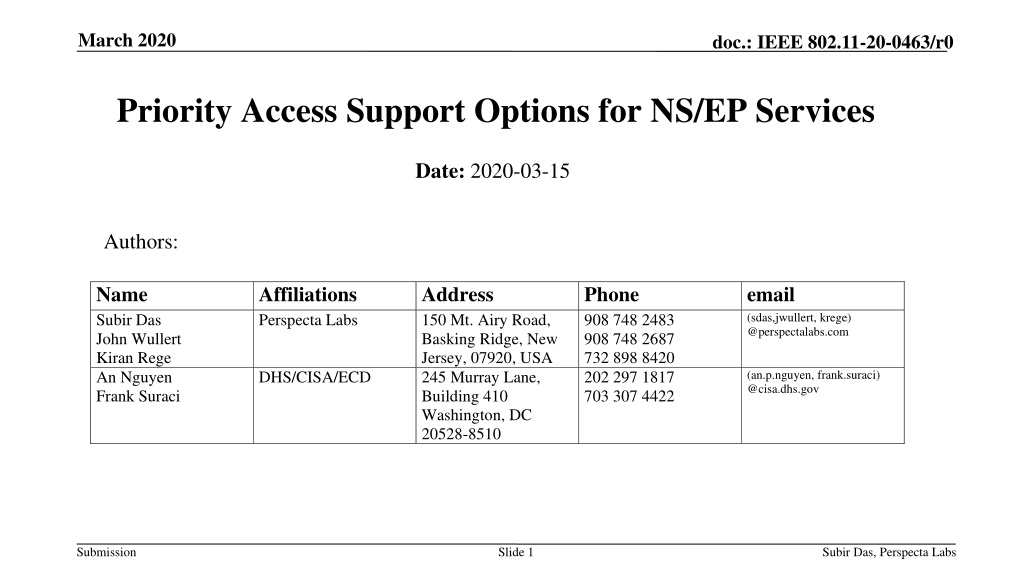
Support Options for NS/EP Services in IEEE 802.11-20-0463/r0
Explore the priority access support options for National Security and Emergency Preparedness services in the IEEE 802.11-20-0463/r0 document. Learn about providing priority access to system resources, authorized users, and existing NS/EP priority services in the US and globally. Discover how priority access can benefit WLANs and other critical services during network congestion or failures.
Download Presentation

Please find below an Image/Link to download the presentation.
The content on the website is provided AS IS for your information and personal use only. It may not be sold, licensed, or shared on other websites without obtaining consent from the author. Download presentation by click this link. If you encounter any issues during the download, it is possible that the publisher has removed the file from their server.
E N D
Presentation Transcript
March 2020 doc.: IEEE 802.11-20-0463/r0 Priority Access Support Options for NS/EP Services Date: 2020-03-15 Authors: Name Subir Das John Wullert Kiran Rege An Nguyen Frank Suraci Affiliations Perspecta Labs Address 150 Mt. Airy Road, Basking Ridge, New Jersey, 07920, USA 245 Murray Lane, Building 410 Washington, DC 20528-8510 Phone 908 748 2483 908 748 2687 732 898 8420 202 297 1817 703 307 4422 email (sdas,jwullert, krege) @perspectalabs.com DHS/CISA/ECD (an.p.nguyen, frank.suraci) @cisa.dhs.gov Submission Slide 1 Subir Das, Perspecta Labs
March 2020 doc.: IEEE 802.11-20-0463/r0 Outline This presentation covers the following: Overview of NS/EP Priority Services Assumptions Options for supporting priority access to NS/EP Priority Service non-AP STA(s) using OFDMA-based Triggered Uplink Access (TUA) Submission Slide 2 Subir Das, Perspecta Labs
March 2020 doc.: IEEE 802.11-20-0463/r0 Overview Priority access support for National Security and Emergency Preparedness (NS/EP) priority services was approved as a work item in IEEE 802.11be during January 2020 meeting [1] Objective Summary A standardized mechanism to support the NS/EP priority services in WLANs without requiring additional infrastructure Priority Access in IEEE 802.11be would also be beneficial to other services ( e.g., Public- Safety Mission-Critical Services, Critical medical applications) Submission Slide 3 Subir Das, Perspecta Labs
March 2020 doc.: IEEE 802.11-20-0463/r0 NS/EP Priority Services Service Objective: Provide priority access to system resources for a limited set of authorized users during network congestion Priority Access: Allow preferred access to the wireless medium during network congestion and/or failures to establish a data session Limited Set: Number of users is generally a small fraction of the overall user base Authorized Users: Only available to some designated individuals who are identified to receive such service Existing NS/EP Priority Services in the US provide priority voice calls over public networks Government Emergency Telecommunications Service (GETS): Legacy landline phone networks Wireless Priority Service (WPS): Wireless phone networks Next Generation Network Priority Services (NGN-PS): Providers IP-based communications networks Many countries have similar priority telecommunications services, e.g., Belgium: Blue Light Mobile, Canada: WPS, Czech Republic: Mobile Crisis Communications service, Great Britain: MTPAS GSM for Railway Communications deployed in multiple countries NS/EP Priority Services are NOT Emergency Services (e.g., E911 in US; 112, 999, etc. in Europe) Submission Slide 4 Subir Das, Perspecta Labs
March 2020 doc.: IEEE 802.11-20-0463/r0 Assumptions NS/EP Priority Service user s non-AP STA is associated with BSS prior to invocation of priority capabilities Attachment, authentication, and authorization occur via standard procedures After association, AP STA has the knowledge of which non-AP STAs are authorized to use NS/EP priority services NS/EP Priority Service user s non-AP STA will identify the need for priority and inform the AP STA Priority remains in effect until terminated by either party Submission Slide 5 Subir Das, Perspecta Labs
March 2020 doc.: IEEE 802.11-20-0463/r0 Use of OFDMA TUA for NS/EP Priority Services Enabling priority in OFDMA scheduling (in presence of network congestion) AP sends Trigger Frame (e.g. BSRP) with periodic poll to non-AP STAs to determine data to be sent upstream Subsequent messages may not require the Trigger NS/EP-user non-AP STA reports access class and buffer status with priority indication AP STA verifies authorization of NS/EP Priority Service user AP STA incorporates higher priority flag into scheduling and RU-allocation decisions for NS/EP Priority Service non-AP STA Submission Slide 6 Subir Das, Perspecta Labs
March 2020 doc.: IEEE 802.11-20-0463/r0 Use of OFDMA TUA for NS/EP Priority Services Options Option 1: Use existing Trigger Frame (e.g., BSRP) with periodic poll and extend QoS Control Field format to indicate the NS/EP Priority Service non-AP STA status in buffer status report Option 2: Define a new Trigger Frame and corresponding Report format exclusively for supporting the NS/EP Priority Services Submission Slide 7 Subir Das, Perspecta Labs
March 2020 doc.: IEEE 802.11-20-0463/r0 QoS Control Field Format for IEEE 802.11ax QoS Control Field Format A-MSDU Present TID 1 Ack Policy Queue Size QoS Control field QoS Control field enables non-APSTA to report the buffer status after receiving the Trigger Frame (e.g., BSRP) poll from an AP STA Non-AP STA can send multiple QoS Control fields to indicate requirements for multiple TCs Non-AP STA sends QoS Control field with TID and Queue Size in QoS Data or QoS Null frame TID (4 bits) maps to User Priority (UP) value UP Values 0-7 are assigned Values from 8 to 15 are not used in QoS frames since STAs do not use HCCA Submission Slide 8 Subir Das, Perspecta Labs
March 2020 doc.: IEEE 802.11-20-0463/r0 Option 1: Extending QoS Control Field Format QoS Control field Format bits 5-6 bits 8-15 bit 3 bit 7 bits 0-2 bit 4 A-MSDU Present PS TID 1 Ack Policy Queue Size Encode priority in QoS Control field TID Rationale: Only 0-7 is used for indicating the UP values Proposal: Assign bits 0-2 for TID and use bit 3 for indicating NS/EP Priority Service PS is set to 1 for NS/EP Priority Service and otherwise set to zero Impact: Non NS/EP Priority Service STAs will not be able to decode this information but this should not be an issue since MIB can be updated to address the backward compatibility Submission Slide 9 Subir Das, Perspecta Labs
March 2020 doc.: IEEE 802.11-20-0463/r0 Option 2: Dedicated Trigger/Report for NS/EP Priority Services Define a new Trigger Frame to request NS/EP Priority Services information Trigger asks NS/EP-aware and authorized non-AP STAs to report the need for NS/EP Priority Services Non-AP STAs can respond to enable/disable NS/EP Priority Services for specific ACs AP STA sends trigger periodically or based on some internal policy, for example, Sends only if at least one NS/EP-authorized STA is associated with BSS Sends only if BSS load exceeds specified threshold New Trigger frame can be a variant of existing Trigger frame format New trigger type subfield can be allocated from reserved set (8-15) Submission Slide 10 Subir Das, Perspecta Labs
March 2020 doc.: IEEE 802.11-20-0463/r0 Option 2: Dedicated Trigger for NS/EP Priority Services (Continued) Need a reporting frame that will enable non-AP STAs to: Respond to NS/EP Priority Service trigger poll Can possibly make unsolicited requests for NS/EP Priority Service Specify ACs that require NS/EP Priority Service If possible include user s NS/EP Priority level (one of five) Report queue size for each AC Possible to define a format similar to the QoS Control field or BSR (with some modifications) Include multiple instances in an aggregate, one for each AC Submission Slide 11 Subir Das, Perspecta Labs
March 2020 doc.: IEEE 802.11-20-0463/r0 Option 2: Dedicated Trigger for NS/EP Priority Services (Continued) Pros Flexibility to represent specific information related Priority Services No interference with existing features Cons New Trigger Frame and report structure need to be defined to support the NS/EP Priority Service Submission Slide 12 Subir Das, Perspecta Labs
March 2020 doc.: IEEE 802.11-20-0463/r0 Summary Described two possible approaches One leverages existing protocol constructs with updates Other one requires defining additional protocol elements Feedback and comments ?? Submission Slide 13 Subir Das, Perspecta Labs
March 2020 doc.: IEEE 802.11-20-0463/r0 References [1] 11-19-1901-04-00be-priority-access-support-in-ieee-802-11be-what-and-why.pptx [2] 11-20-0021-01-00be-Priority-Access-support_for_NS_EP_Services.pptx, [2] IEEE P802.11ax /D6.0, Part 11: Wireless LAN Medium Access Control (MAC) and Physical Layer (PHY) Specifications, Amendment 1: Enhancements for High Efficiency WLAN , November 2019 [3] IEEE Std 802.11 -2016, Part 11: Wireless LAN Medium Access Control (MAC) and Physical Layer (PHY) Specifications , 7 December 2016 Submission Slide 14 Subir Das, Perspecta Labs

